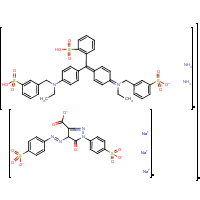Aquashade
Agent Name
Aquashade
CAS Number
92170-50-8
Formula
C37-H36-N2-O9-S3.C16-H9-N4-O9-S2.2H3-N.3Na
Major Category
Pesticides

Synonyms
Benzenemethanaminium, N-ethyl-N-(4-((4-(ethyl((3-sulfophenyl)methyl)amino)phenyl)(2-sulfophenyl)methylene)-2,5-cyclohexadien-1-ylidene)-3-sulfo-, inner salt, diammonium salt, mixt. With 4,5-dihydro-5-oxo-1-(4-sulfophenyl)-4-((4-sulfophenyl)azo)-1H-pyrazole-3-carboxylic acid trisodium salt; Benzenemethanaminium, N-ethyl-N-(4-((4-(ethyl((3-sulfophenyl)methylamino)phenyl)(2-sulfophenyl)methylene)-2,5-cyclohexadien-1-ylidene)-3-sulfo-, hydroxide, inner salt, diammonium salt, mixt. 4,5-dihydro-5-oxo-1-(4- sulfophenyl)-4-((4-sulfophenyl)azo)-1H-pyrazole-3-carboxylic acid trisodium salt; [ChemIDplus]
Category
Herbicides, Other
Sources/Uses
A mixture of the dyes erioglaucine (Acid Blue 9) and tartrazine (Acid Yellow 23) that act as aquatic algaecide/herbicide by limiting light wavelengths necessary for photosynthesis; For use in natural and man-made ponds, lakes, fountains, and fish farms and hatcheries; End-use product contains 68% erioglaucine and 4.5% tartrazine [Reference #1]
Comments
Both dyes are FDA approved and regarded as safe for use in foods, drugs, and cosmetics; No target organs for toxicity have been identified in any studies; Mostly excreted as parent compound in feces; A skin sensitizer in animal studies; [Reference #1] See "Tartrazine" and "Cl Acid Blue 9."
Reference Link #1
Biomedical References
Adverse Effects
Skin Sensitizer
Yes
Diseases, Processes, and Activities Linked to This Agent
Diseases
Occupational diseases associated with exposure to this agent:
Processes
Industrial Processes with risk of exposure: